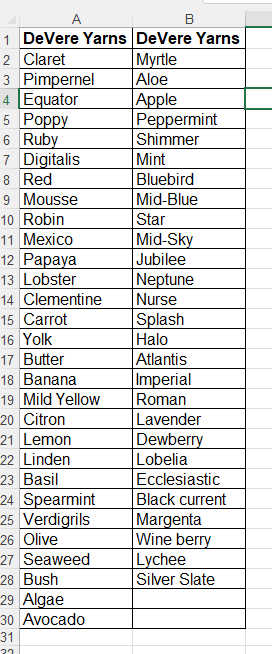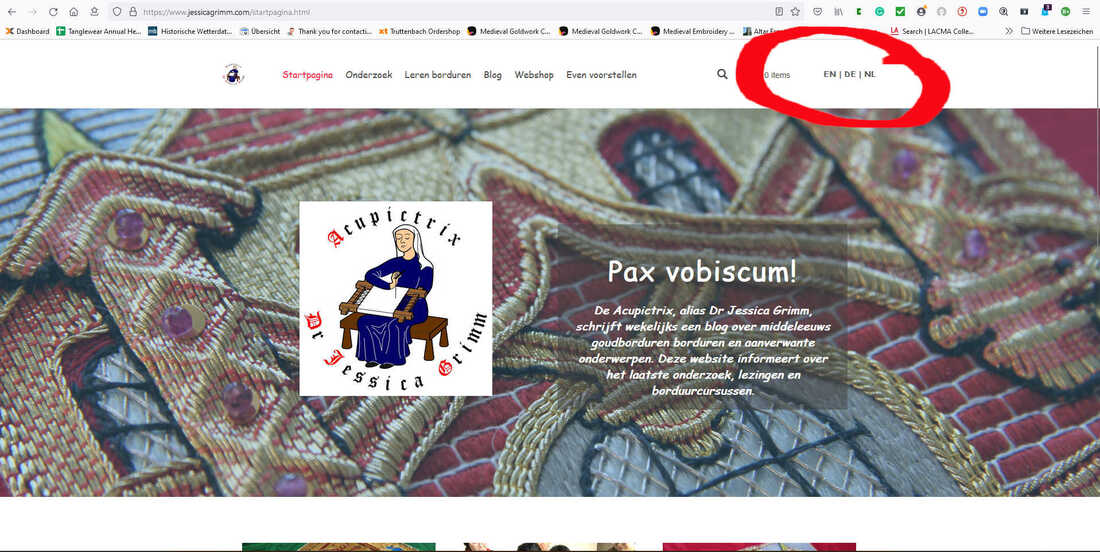|
Some of my students are great enablers! During last week's goldwork workshop in Glentleiten, Mina showed us a neat idea of a stitched heatmap in the form of a tree. I was intrigued. As the whole concept of stitching a heatmap was new to me, I did a Google when I was home. Oh my! Some of these heatmaps are very clever indeed and produce beautiful art. You guessed it: I needed one. As I loved the more abstract varieties best, I decided to buy my pattern from Tanglewear on Etsy. As I am not afraid to customize a project once I've bought the basic idea, I am going to show you what I did. It is going to be very colourful and fancy. And something else: You might have noticed that my website now comes in three languages: English, Deutsch and Nederlands. More on that at the end of this post! What is a stitched heatmap and how does it work? It basically is a sequence of colours in the order of the rainbow that corresponds to the daily maximum and minimum temperature for your chosen location. A piece of nifty software or code translates these two data points into an embroidery cross-stitch pattern. There are abstract heatmap patterns and non-abstract heatmap patterns (the leaves on a tree, for instance). No two stitched heatmaps are completely alike (unless you live in the exact same spot and do it for the same timespan). It is the perfect project to stitch on every day. The best thing: you have no idea what the pattern will look like when you stitch 'in the now'. After all, I don't know yet what today's maximum and minimum temperatures are going to be. Your personal mystery stitch along! As mentioned: I love to break the rules a little and customize materials to my taste. Raina of Tanglewear provides a pattern based on DMC stranded-cotton. However, once you get your head around the principle, changing this to a thread range you like is very easy. I spend the best part of a day coming up with a colour range in DeVere Yarns silk (#6). They all lived in my stash and this is a lovely project to work in silk. In the short video, you can see all the colours I picked in order. That alone looks pretty yummy to me! Above is a list of all the DeVere colours that will be in my heatmap. And next to it is the first week of my heatmap (the 11th of July on the left and the 17th of July on the right). I am stitching on 48ct linen (Sotema 30L Ricamo colour Candido). As DeVere silk #6 is very fine, I go over each stitch of the cross-stitch twice. This is in effect stitching with two threads but without the hassle of trying to keep correct tension on two very whispy silk threads :). As I am living in the foothills of the Alps, we get quite erratic weather. This will translate into a pretty striped heatmap with lots of colour changes from day to day. Stitching each day is no big deal: 84 crosses. That's all. So I am thinking of stitching back into the past as well. This would produce my own documentation of local climate change. Something that has been on my mind a lot since really freaky weather started to happen here a couple of years ago and continues to happen ever since. If I have inspired you to produce your own (epic) band sampler of local weather, please do let me know in the comments! But that was not all the workshop at Glentleiten sparked! Maria told me that it is really hard to find me on the internet when you use a search engine with German keywords. When I started to look into this, it soon became clear that this is due to the algorithm of the biggest search engine of them all. Google favours content written in German when searched in Germany. No matter how relevant the English content is to your search, you are probably only shown lesser fitting results that are available in German. Bummer.
The easiest solution is to create a website with multiple language options. No small feat for a person as dyslectic as I am ... I decided to bite the bullet and hire a Weebly website developer to implement the structural changes. Vladimir was insanely quick and fantastic to work with. All subpages on my website are now available in English, Deutsch and Nederlands (it is a very basic translation at the moment, but it will be cleaned up over the next couple of months). You can switch between these languages at the top right. Unfortunately, Weebly does not allow you to translate the webshop part of the website. That needs to stay in English. For the moment, I am not translating the blog into Deutsch or Nederlands either. However, you can sign up for a monthly newsletter in either Deutsch or Nederlands in which I will summarize that month's blog content and English newsletter content in either Deutsch or Nederlands. The first monthly newsletters are planned for the end of July. When interest in either or both of these newsletters gains traction, I might decide to start translating the blog as well. This means that when you want to read the blog content in Deutsch or Nederlands, use the button below to sign-up for the monthly newsletter in either Deutsch or Nederlands!
3 Comments
18/7/2022 19:31:34
Oh yes! No complaining about the approaching heatwave here: it will mean that I can stitch with the next pretty colour :).
Reply
27/7/2022 20:05:25
I've seen heatmaps done in knitting, as quilts and with weaving. All the ones I've seen have been from 4-season climates. I suppose that places which don't have a big variation could still use different colors for each hour, but I don't think it would be as dramatic....
Reply
Your comment will be posted after it is approved.
Leave a Reply. |
Want to keep up with my embroidery adventures? Sign up for my weekly Newsletter to get notified of new blogs, courses and workshops!
Liked my blog? Please consider making a donation or becoming a Patron so that I can keep up the good work and my blog ad-free!
Categories
All
Archives
April 2024
|
Contact: info(at)jessicagrimm.com
Copyright Dr Jessica M. Grimm - Mandlweg 3, 82488 Ettal, Deutschland - +49(0)8822 2782219 (Monday, Tuesday, Friday & Saturday 9.00-17.00 CET)
Impressum - Legal Notice - Datenschutzerklärung - Privacy Policy - Webshop ABG - Widerrufsrecht - Disclaimer
Copyright Dr Jessica M. Grimm - Mandlweg 3, 82488 Ettal, Deutschland - +49(0)8822 2782219 (Monday, Tuesday, Friday & Saturday 9.00-17.00 CET)
Impressum - Legal Notice - Datenschutzerklärung - Privacy Policy - Webshop ABG - Widerrufsrecht - Disclaimer








 RSS Feed
RSS Feed